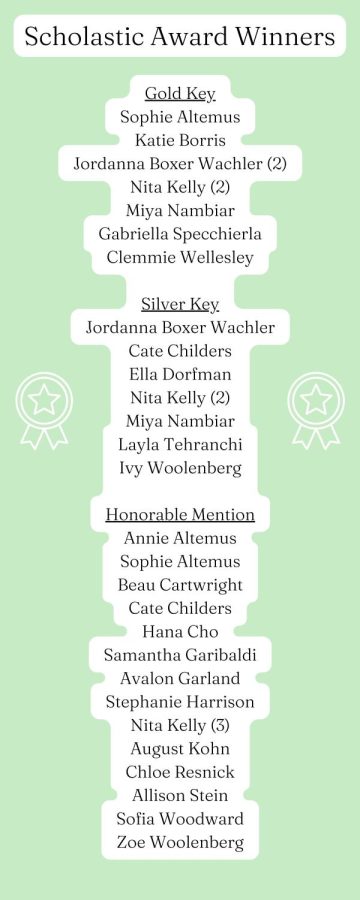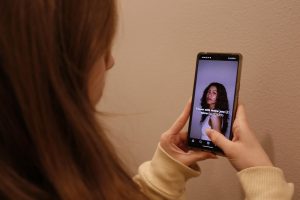The Art-cher School for Girls: students submit to Scholastic Art Awards, explore creative processes
Photo credit: Zoe Woolenberg
“Earth Guitar” depicts Woolenberg’s favorite guitar in her home that has butterflies on it. Woolenberg’s photograph demonstrates her theme of “sandwiching negatives,” and it won an Honorable Mention.
March 4, 2023
Five minutes left. The internet is lagging, and it’s Dec. 7, 2022 — the last day to apply to the Scholastic Art Awards. Junior Nita Kelly’s files are uploading slowly, and the completion bar is nowhere near 100%. Now, 30 seconds remain, and the files haven’t fully uploaded. The deadline passes. Kelly still has five pieces of her art that aren’t uploaded, but she decides to submit the five that did upload.
The next day, she receives an email from the Scholastic organization saying the deadline has been extended, and Kelly submits the remaining files and awaits her results. This was the first time Kelly ever submitted to the Scholastic Art Awards, and she ended up receiving seven awards from all categories.
The Scholastic Awards were founded in 1983 and have continuously hosted nationwide competitions for teens in writing and art. Scholastic Awards conducts competitions at both the regional and national level, and participants can win a Gold Key, Silver Key or an Honorable Mention for their regional submissions. At Archer, 28 students were awarded for their regional submissions in the 2023 arts competition. Students paid $10 per individual entry and $30 per portfolio entry.
Kelly has been developing her artistic skills since elementary school and has continued to challenge herself through studio art courses at Archer. Kelly said these classes have helped her build a portfolio, which she used to submit to the Scholastic Awards.
“When I was making the art, I didn’t even realize until the week before Scholastic that it was happening. I’ve actually never applied for Scholastic before,” Kelly said. “I got the results back, and I was really shocked. But it was really, really nice to hear.”

Kelly learned about the Scholastic Awards through Archer, where she said she has also been able to explore oil painting, an art form she initially thought was too advanced. Visual Arts Department Chair Maya Alford said that the competitive nature of the Scholastic Awards does not motivate every artist, but those who do submit their work develop new skills.
“Students who did not expect to get any type of recognition are so surprised when they see a silver, gold or honorable mention come through,” Alford said. “They were getting feedback from their classmates. But, of course, it means something else when there’s a board reviewing your artwork and honoring you with this award.”
Senior Zoe Woolenberg submitted her photo “Earth Guitar” to the Scholastic Art Awards, and it won an Honorable Mention. Her photograph pictured a guitar sandwiched between the texture of tree bark because she was exploring the theme of “sandwiching negatives.” Woolenberg said she faced obstacles while developing the photograph.
“You really have to figure out the perfect amount of time to expose your piece so you get the right amount of light in it and darkness,” Woolenberg said. “That definitely takes experimenting, especially when you’re sandwiching two pieces because they both need different amounts of light.”
 While Woolenberg had a theme for her submission, Kelly said she usually does not follow a theme and enjoys having creative freedom to design her artwork.
While Woolenberg had a theme for her submission, Kelly said she usually does not follow a theme and enjoys having creative freedom to design her artwork.
“I don’t think I ever consciously really think about a message that I’m necessarily trying to spread through the art. But, I think that a lot of it comes from an emotional place,” Kelly said. “Usually, it’s more so a release for me. Art is really the one thing that comes intuitively, and I let it be without necessarily attaching any expectations to it.”
In addition to being the visual arts department chair, Alford teaches introductory and advanced photography courses. She said independence is a major part of being an artist, especially for students who want to find their own artistic space and purpose.
“It’s also important to not close yourself down once you’ve become a more independent artist because artists are always seeking — they’re growing from their colleagues, and they’re growing from their peers,” Alford said. “Be independent, but also be open to critique and feedback and exploration.”
While Kelly prefers working on her own outside of classes, Woolenberg said she enjoys the open-ended projects Alford gives her in Advanced Photography.
“I love open-ended projects [because] we really have a lot of freedom with it,” Woolenberg said. “You can explore anything you want, and I think something that’s been special is being able to add on to certain themes throughout the year.”
Kelly created most of her submissions outside of school because she said she finds comfort in working at home. Kelly said that she doesn’t attach academic expectations to her art, and that her art is personal to her.
“I feel like what makes art so special is that it can be anything to any person,” Kelly said. “It’s to each their own really. I don’t think any one person has the power to say what is and isn’t art.”









